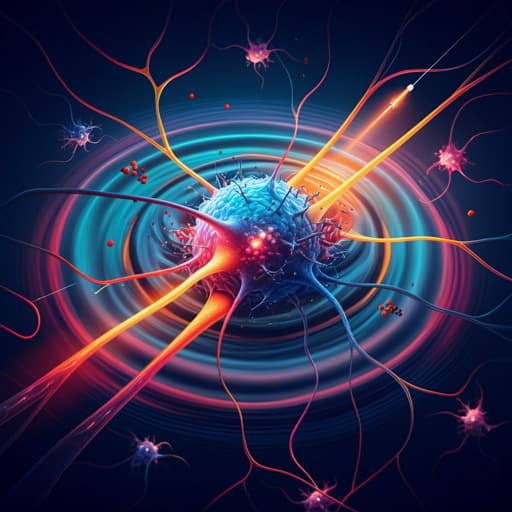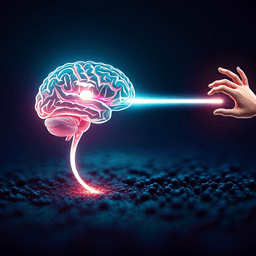
Biology
Massive Solubility Changes in Neuronal Proteins upon Simulated Traumatic Brain Injury Reveal the Role of Shockwaves in Irreversible Damage
A. A. Saei, H. Gharibi, et al.
This study by Amir Ata Saei, Hassan Gharibi, Hezhe Lyu, Brady Nilsson, Maryam Jafari, Hans Von Holst, and Roman A Zubarev unveils the immediate molecular impacts of traumatic brain injuries (TBIs) using an innovative proteomics method. By simulating TBIs in the lab, researchers discovered significant changes to the neuronal proteome and introduced a new proteome-based 'shock meter' to assess cell damage.
~3 min • Beginner • English
Introduction
Traumatic brain injury (TBI) is a major global health problem affecting around 70 million people annually and is linked to significant morbidity, mortality, and long-term consequences such as dementia. Despite preventive measures like helmets, severe outcomes still occur, and current treatments for moderate to severe TBI remain challenging, with complications such as refractory intracranial hypertension often necessitating decompressive craniotomy. While numerous secondary injury mechanisms have been characterized (e.g., excitotoxicity, mitochondrial dysfunction, neuroinflammation, oxidative stress, impaired autophagy/lysosomal pathways, and apoptosis), first-generation primary molecular events immediately following impact are less understood. Many therapeutic efforts have targeted secondary processes, yet over 30 candidate diagnostics or therapeutics have failed in clinical trials, partly due to limited understanding of primary injury mechanisms. The authors hypothesized that external impact causes protein unfolding that triggers downstream TBI phenomena. Building on prior work showing dynamic pressure pulses can affect protein aggregation states (e.g., laminin), they simulate dynamic impacts on human-brain-derived SH-SY5Y cells using a 5.1 kg dummy head apparatus generating up to ~4000 g accelerations. They apply the Proteome Integral Solubility Alteration (PISA) assay to monitor proteome-wide solubility changes, aiming to differentiate effects of shockwaves from acceleration and to identify immediate molecular changes that could underpin irreversible cellular damage, inform biomarker discovery, and aid design of preventive interventions.
Literature Review
Methodology
- Dynamic impact simulation: SH-SY5Y human neuroblastoma cells were cultured in 35 mm Nunclon dishes (10 mm height) to ~250,000 cells/dish. Dishes were placed in a 5.1 kg dummy head dropped from heights of 55–110 cm onto a static bottom plate (hard surface) to produce dynamic impacts; some experiments used an energy-absorbing mat (isobutylene–isoprene rubber pyramids, 6 mm height on 2 mm base membrane) covering the plate. An ICP shock accelerometer (PCB Piezotronics model 350D02) recorded g-force time profiles via PicoScope 6.
- Viability assays: Following impacts, cells were either processed immediately or cultured for 24–48 h. Viability was measured with CellTiter-Blue (six biological replicates). Trypan Blue exclusion assessed membrane integrity. For acceleration-only controls, cells in PBS (250,000 cells/300 µL) were centrifuged at 312–20,000× g for 10 min, then replated and assayed for viability at 24 and 48 h.
- PISA assay: Immediately post-impact (55 cm hard vs soft floor) and in acceleration-only conditions (1250 and 2500× g), cells were processed by PISA in five biological replicates. Cells were washed, scraped into PBS, aliquoted (10 per sample), heated in a 48–59°C gradient for 3 min, cooled, snap-frozen, pooled per replicate, freeze–thawed, and ultracentrifuged (100,000× g, 20 min, 4°C). Soluble proteins were quantified (BCA), reduced/alkylated (DTT/IAA), precipitated (methanol/chloroform), resolubilized (EPPS/urea), digested (LysC overnight, then trypsin 6 h), TMTpro-16plex labeled, quenched, combined, acidified, cleaned (Sep-Pak), dried, and fractionated (high-pH reversed-phase; 96 fractions concatenated to 16; centrifugation PISA concatenated to 12).
- LC–MS/MS: Nano-UHPLC coupled to Orbitrap Q Exactive HF. Gradients 180 min (impact PISA) or 150 min (centrifugation PISA). MS1 at 120,000 resolution; MS2 at 60,000; HCD NCE 33%; AGC targets 3e6/2e5; max IT 100/120 ms.
- Data processing: MaxQuant v1.6.2.3 with Andromeda searched against UniProt human proteome (UP000005640_9606). Trypsin/P specificity; ≤2 missed cleavages; 1% FDR at peptide/protein; TMTpro-16 quantification; fixed carbamidomethyl-Cys; variable Met oxidation and protein N-term acetylation. Proteins identified by site or contaminants removed; ≥2 peptides required; missing-value proteins removed. Intensities normalized by total channel abundance and log2-transformed; fold changes computed by subtraction. Statistical significance assessed by two-tailed unpaired Student t-test (impact vs control replicates).
- Pathway and network analysis: STRING v11.5 used for enrichment/network mapping of top-affected proteins.
- PCA: Performed on normalized protein abundances; PC1 used as composite metric ("shock meter") with control average set to zero; sample coordinates for soft and hard impacts calculated relative to control.
Key Findings
- Impact accelerations: 55 cm hard floor produced 1556 ± 456 g; 110 cm hard produced 3959 ± 978 g. With energy-absorbing mat: 55 cm yielded 900 ± 289 g; 110 cm yielded 1625 ± 510 g.
- Viability: Dynamic impact reduced viability in a height-dependent manner at 24 and 48 h. Viability further decreased between 24 h and 48 h after hard impact, indicating ongoing cell death. The mat significantly protected up to ~70 cm; at ~105 cm, 48 h viability was statistically indistinguishable between hard and soft impacts. Trypan Blue showed no significant increase in dye-permeable cells, indicating intact membranes and internal damage as the cause of viability loss.
- Proteome solubility changes (PISA): 6708 proteins quantified; final dataset 5612 proteins. After 55 cm hard impact, ~25% of the proteome (1382 proteins) showed significant solubility change (|log2FC| > 0.5, p < 0.05); with soft mat, ~1.5% (86 proteins) changed. PCA PC1 captured 52% of variance and separated conditions: PC1 mean (±SD) control = 0 (reference), soft impact = 18.4 ± 13, hard impact = 117 ± 15; PC1 serves as a proteome-based “shock meter.”
- Protein-level patterns: Many proteins increased solubility (suggesting complex/organelle disruption); a distinct group decreased solubility (likely unfolding). Proteins changing similarly under soft and hard impacts but with larger magnitude under hard were highlighted, including TNFAIP8L2 (immune homeostasis regulator) and collagens COL5A1, COL18A1, COL21A1 (laminin G domain-containing). Proteins with reduced solubility mapped to mitochondrial electron transport/respirasome (ATP5I, UQCRH, NDUFB7, SDHD; p = 0.01) and SEZ6L2 (neuritogenesis/ER functions).
- Neurodegeneration-relevant proteins: APP and APLP2 increased solubility; MAPT (tau) and SNCA (alpha-synuclein) decreased solubility under both hard and soft impacts (lesser magnitude with soft), linking immediate impact-induced changes to pathways implicated in Alzheimer’s and Parkinson’s diseases.
- Pathway enrichment: Top 50 most significantly changed proteins mapped to cell adhesion, collagen trimer, response to stress, and dense networks including immune response, complement, and coagulation cascades. Cellular components enriched included ER (17), extracellular matrix (16), secretory vesicle (13), Golgi apparatus (12), and cytoplasm (42) (all p < 0.02).
- Shockwave vs acceleration: Centrifugation at comparable g-forces (around 1250× g and up to 20,000× g for 10 min) caused modest 24 h viability reductions but no significant decreases at 48 h; viability increased vs 24 h, indicating partial reversibility. PISA showed minimal proteome solubility changes upon centrifugation: only five proteins significant at 2500× g (and none overlapping with dynamic impact top changes), with no coherent pathway enrichment. In contrast, dynamic impact from 55 cm induced drastic solubility changes and enriched pathways, indicating shockwaves, not acceleration, drive irreversible molecular damage.
- Materials mitigation: Energy-absorbing mat attenuated both g-force and proteomic/viability effects at lower drop heights; protection diminished when fully compressed at higher impacts, consistent with shockwave transmission through compressed soft materials.
Discussion
The study demonstrates that dynamic impacts generate shockwaves that are the primary drivers of irreversible molecular and cellular damage, whereas equivalent or greater accelerations applied statically via centrifugation predominantly elicit reversible effects. PISA profiling reveals widespread increases in protein solubility indicative of disrupted complexes and organelles, alongside a subset of proteins with decreased solubility suggesting unfolding, particularly in mitochondrial respiratory chain components. Immediate solubility changes in APP/APLP2 (stabilization) and MAPT/SNCA (destabilization) provide a mechanistic link between acute TBI and later neurodegeneration, potentially exacerbated by compromised protein quality control (e.g., autophagy deficits). The proteome-level response is succinctly captured by PCA PC1, enabling a quantitative, proteome-based “shock meter” to grade impact severity and distinguish reversible from irreversible damage signatures. The authors propose that increased solubility may expand hydration shells, promoting cellular swelling and contributing to cytotoxic edema. Energy-absorbing materials confer protection until mechanically saturated, after which shockwaves propagate similarly to hard surfaces. Collectively, findings refine the understanding of primary injury mechanisms in TBI and highlight protein complex disruption/unfolding and specific pathways (adhesion, ECM, immune, complement/coagulation) as immediate responders to shockwaves.
Conclusion
This work introduces a laboratory model of TBI that separates shockwave effects from acceleration and applies PISA proteomics to capture immediate proteome solubility changes that underpin irreversible neuronal damage. Key contributions include: (1) evidence that shockwaves, rather than g-force acceleration, drive irreversible cell death and proteome destabilization; (2) identification of extensive, pathway-level solubility changes (adhesion/ECM, immune, complement/coagulation) and neurodegeneration-relevant proteins (APP, APLP2, MAPT, SNCA); (3) development of a quantitative proteome-based “shock meter” (PCA PC1) to assess impact severity; and (4) demonstration that soft, energy-absorbing materials mitigate impacts only up to their compression limits. The authors suggest future work to: validate proteome-based shock meters in more physiological models and in vivo; identify and validate protein biomarkers for clinical TBI grading and prognosis; explore therapeutic targets to prevent complex disruption/unfolding; and use proteome metrics to design and evaluate helmets and flooring aimed at primary prevention.
Limitations
Related Publications
Explore these studies to deepen your understanding of the subject.







